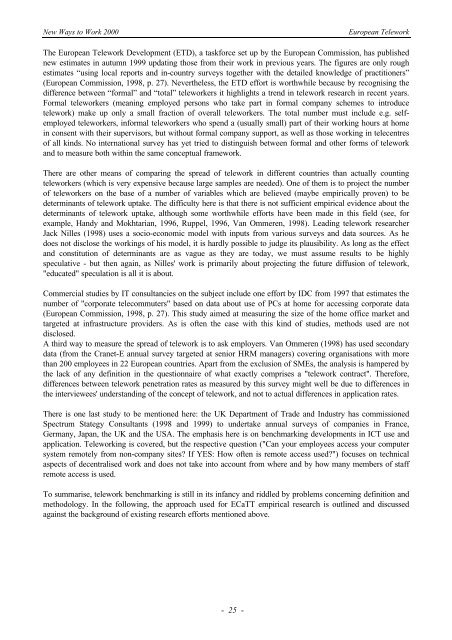eWORK 2000 - European Telework Week
eWORK 2000 - European Telework Week
eWORK 2000 - European Telework Week
- No tags were found...
Create successful ePaper yourself
Turn your PDF publications into a flip-book with our unique Google optimized e-Paper software.
New Ways to Work <strong>2000</strong><strong>European</strong> <strong>Telework</strong>The <strong>European</strong> <strong>Telework</strong> Development (ETD), a taskforce set up by the <strong>European</strong> Commission, has publishednew estimates in autumn 1999 updating those from their work in previous years. The figures are only roughestimates “using local reports and in-country surveys together with the detailed knowledge of practitioners”(<strong>European</strong> Commission, 1998, p. 27). Nevertheless, the ETD effort is worthwhile because by recognising thedifference between “formal” and “total” teleworkers it highlights a trend in telework research in recent years.Formal teleworkers (meaning employed persons who take part in formal company schemes to introducetelework) make up only a small fraction of overall teleworkers. The total number must include e.g. selfemployedteleworkers, informal teleworkers who spend a (usually small) part of their working hours at homein consent with their supervisors, but without formal company support, as well as those working in telecentresof all kinds. No international survey has yet tried to distinguish between formal and other forms of teleworkand to measure both within the same conceptual framework.There are other means of comparing the spread of telework in different countries than actually countingteleworkers (which is very expensive because large samples are needed). One of them is to project the numberof teleworkers on the base of a number of variables which are believed (maybe empirically proven) to bedeterminants of telework uptake. The difficulty here is that there is not sufficient empirical evidence about thedeterminants of telework uptake, although some worthwhile efforts have been made in this field (see, forexample, Handy and Mokhtarian, 1996, Ruppel, 1996, Van Ommeren, 1998). Leading telework researcherJack Nilles (1998) uses a socio-economic model with inputs from various surveys and data sources. As hedoes not disclose the workings of his model, it is hardly possible to judge its plausibility. As long as the effectand constitution of determinants are as vague as they are today, we must assume results to be highlyspeculative - but then again, as Nilles' work is primarily about projecting the future diffusion of telework,"educated" speculation is all it is about.Commercial studies by IT consultancies on the subject include one effort by IDC from 1997 that estimates thenumber of "corporate telecommuters" based on data about use of PCs at home for accessing corporate data(<strong>European</strong> Commission, 1998, p. 27). This study aimed at measuring the size of the home office market andtargeted at infrastructure providers. As is often the case with this kind of studies, methods used are notdisclosed.A third way to measure the spread of telework is to ask employers. Van Ommeren (1998) has used secondarydata (from the Cranet-E annual survey targeted at senior HRM managers) covering organisations with morethan 200 employees in 22 <strong>European</strong> countries. Apart from the exclusion of SMEs, the analysis is hampered bythe lack of any definition in the questionnaire of what exactly comprises a "telework contract". Therefore,differences between telework penetration rates as measured by this survey might well be due to differences inthe interviewees' understanding of the concept of telework, and not to actual differences in application rates.There is one last study to be mentioned here: the UK Department of Trade and Industry has commissionedSpectrum Stategy Consultants (1998 and 1999) to undertake annual surveys of companies in France,Germany, Japan, the UK and the USA. The emphasis here is on benchmarking developments in ICT use andapplication. <strong>Telework</strong>ing is covered, but the respective question ("Can your employees access your computersystem remotely from non-company sites? If YES: How often is remote access used?") focuses on technicalaspects of decentralised work and does not take into account from where and by how many members of staffremote access is used.To summarise, telework benchmarking is still in its infancy and riddled by problems concerning definition andmethodology. In the following, the approach used for ECaTT empirical research is outlined and discussedagainst the background of existing research efforts mentioned above.- 25 -








